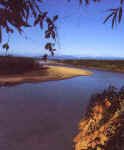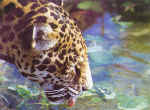|
|
 In the Heart of Candamo
In the Heart of Candamo![]()
![]()
The forest surrounding the community is now a shadow of its former self. These days macaws fly by giving the village a wide berth and the larger fish are about as common as trees in an office complex. There is, nonetheless, a place where the jungle is as rich and bountiful as ever, where man is the rare species, and nature continues to reign as it has for millions of years. That place is Candamo and some call it the ‘last human-free jungle’.
"It is said that at the beginning of time all things were people, like us. The stars lived on the Earth, leading a life of sloth and promiscuity, and lusting after the females of other creatures. Eventually, the gods decided to put a stop to this unseemly behavior and condemned the stars to an eternal punishment that would stand as an example to others. The gods banished the female stars to the dark heavens, from where they have been shining down on the forests ever since. The male stars were left behind on Earth to inhabit the jungles and endure a life of loneliness without the solace of their companions. This too is how fireflies were born; it is said that now, whenever a shooting star appears in the sky, all the fireflies tear off after it hoping to be reunited with their loved one, who has broken free from the sky to be reunited with them once more."
In today’s cynical world myths and beliefs like these may seem fragile and vulnerable. Nevertheless, they are as firmly entrenched in Indian cosmology as the hardest hardwood or the largest river boulder. These myths represent the oral tradition of the Amazonian peoples and explain their identities and relationships with their gods and ancestors. Thanks to this tradition, men like Mañuco and Mishaja learned from their fathers how turtles are man’s friend, watching over him and protecting him from the dreaded eels; how certain vines can quench a walker’s thirst; and that the cry of the toucan announces impending rain.
 It is nearly 10 p.m. and the campfire does its level best to penetrate the
darkness blanketing the central clearing of Infierno, a native village three
hours by canoe from Puerto Maldonado. Sitting cross-legged around the campfire a
dozen men, women and children listen rapt to Mishaja’s stories. They have
heard them all hundreds of times, but each night is like the first time. And
with every telling, the storyteller introduces at whim new twists and
embellishments that keep his audience on their toes and in stitches for hours.
It is nearly 10 p.m. and the campfire does its level best to penetrate the
darkness blanketing the central clearing of Infierno, a native village three
hours by canoe from Puerto Maldonado. Sitting cross-legged around the campfire a
dozen men, women and children listen rapt to Mishaja’s stories. They have
heard them all hundreds of times, but each night is like the first time. And
with every telling, the storyteller introduces at whim new twists and
embellishments that keep his audience on their toes and in stitches for hours.
Mishaja, whose Christian name is Agustín, belongs to a community of nearly sixty Ese’Eja indians who still live in the jungles of south-east Peru. They, along with many other ethnic Amazonian peoples, see the very existence of their traditions, customs and people increasingly threatened by modern society as it relentlessly imposes its own rhythms on their lives.
Until quite recently, very few people knew that a tropical forest even existed in the southerly department of Puno, associated as it is with the quiet, deep blue waters of Lake Titicaca and the mushroom-shaped hats of the altiplano peasant women.
Agustín Mishaja was perhaps the first of the Ese’Eja to see those remote lands. At the age of ten, carrying nothing but his bow and arrows, he and his father set off to explore lands at higher altitude, hoping to find them well stocked with game and fish. His people, who were once nomads, needed to move because their settlement, situated between the Chuncho and La Torre Rivers, was nearly hunted out.
Agustín and his father walked for weeks through virgin forest, passing unspoilt rivers, and travelling through areas where no human being had ever set foot. Eventually they came upon a settlement inhabited by colonists who were beavering away, cutting down and sawing up trees. This was Agustín’s first encounter with the white man. Today, almost four decades later, that settlement, now called Sandía, is the main frontier town in the mountain jungles of Puno.
Soon afterwards Agustín and his father returned to their people and told them about the white men and of the modern saws and tools they had never seen, let alone touched, before. However, Agustín had been more impressed by the forests they had found. Despite the novelty of the colonists, the lush jungle through which they had walked had cast a much stronger spell on his imagination.
He had never seen so many macaws, tapirs or deer in one area. Fish swam quietly in crystal-clear rivers. They even had a couple of close shaves with a jaguar. Though normally wary of man, the jaguar tops the jungle food chain and this one decided to let the travellers know it, twice forcing them to take their chances in the river in order to escape.
Journey to Ends of the Earth
The Candamo Reserve is in the far south of Puno Department at around 2,800 feet above sea level. The jumping-off point for the trip is the noisy river town of Puerto Maldonado, located at the confluence of the Tambopata and Madre de Dios rivers.
Boarding a privately chartered canoe, fitted as standard with an outboard engine, several cans of petrol, and the ubiquitous peque-peque motor (named for the sound it makes) in reserve, we set off on our chosen route, the first leg of which involves a full day’s journey up the Tambopata River. Our first day of travel takes us beyond Infierno and the mouths of the La Torre, Malinowski, and Chuncho Rivers to a campsite on a quiet sandy beach on the Upper Tambopata, leaving the nearest human outpost on the river far behind.
The next day we turn off the Tambopata to continue up the scenic Távara River, a tributary fed by clear waters descending from the mountains. Aeons of erosion have carved a spectacular canyon through the lush tropical forest. Piloting a boat up the Távara is a task for experienced boatmen only. With only a few feet of clearance below and stiff currents, to say that negotiating the river’s many rock-strewn sections can be interesting is putting it mildly. In parts, boats even have to be lifted over tree trunks and other obstacles.
Depending on the experience of your captain and the height of the river, covering the length of the Távara River can take anything between one and three days. Eventually however, the river divides into two narrower watercourses: to the left, the surging Guacamayo —made too treacherous to navigate by keel-snapping boulders— and to the right, the Candamo and our objective.
The Enchanted Forest
The first few miles up the Candamo is much the same as the Távara, with frequent waterfalls and tricky sections to pass. After a few hours, however, the river deepens and the outboard becomes more than just ballast. Here, in an indescribably beautiful mountain landscape, the valley opens out to form an immense, bowl-shaped, undulating plain. The almost permanent cloud cover makes aerial observation impossible, even for the prying eyes of satellites. No prizes, then, for guessing why scientists have christened the area La Nube (The Cloud).
It takes almost five days by river to reach the heart of the Candamo Reserve, a vast expanse covering nearly a million hectares, where there is almost no human presence, and nature has been left to unfold with unabashed vitality. Beaches set in polished stone are home to the capybara (the world’s largest rodent), which competes for tender plant shoots with herds of tapir and red brocket deer. The quiet, clear waters are the habitat of gigantic black catfish and schools of other fish, including paco, sábalo, and doncella. These waters are also the preserve of alligators and the largest river otters in the world.
The surrounding forest, dense and virtually impenetrable, provides a refuge for the ocelot, puma and jaguar that roam these parts, stalking large herds of collared and white-lipped peccaries. Closer inspection of trees will reveal sloths, anteaters, porcupines and coaties, as well as hoards of birds, that try to outdo each other in colour and originality: guans, whose cry sounds like a great tree falling; raucous parrots and macaws; toucans with beaks that look as if they’ve had a run-in with a modern artist’s brush; and diminutive tanagers, whose feathers are all the colours of the rainbow picked out with metallic highlights.
All in all, the place is a naturist’s paradise and, though tragically ironic, the ‘promised land’ of the indians, whose dreams of finding an intact jungle home seem ever more remote.
Mishaja removes the last smouldering brand from the fire and carefully rubs it on the damp earth so that it won’t burn up needlessly. It is time to get some sleep and mothers drift slowly homeward taking their tired charges with them. The moon illuminates Infierno’s central clearing with unusual brightness as the two friends sit and smoke in silence watching the river. An unspoken thought lies between them but no words are necessary. There is only one thing on their minds and it will fuel their dreams tonight: one day we’ll return to Candamo.
![]()
By Walter Wust
Volume /Issue 15, Page 03
Updated, Lola Salas
[Top of Page] ![]() http://www.rumbosperu.com
http://www.rumbosperu.com